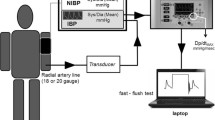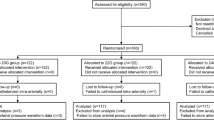Abstract
In pediatric cardiac surgery patients, when an artifact due to overdamping or to underdamping is suspected to affect the invasive arterial blood pressure (IABP) measure and waveform, a check against non-invasive blood pressure (NIBP) could be useful. In this study, we aimed to retrospectively analyze the differences between IABP (single site) and NIBP, measured at four limbs in children admitted to pediatric cardiac intensive care unit. Overall, 51 patients were enrolled for a total of 546 measurements. Average differences between IABP and NIBP measurements were relatively high with 42% of differences laying within the benchmark value of ± 5 mmHg. Differences on the measures on one limb vs. the others for systolic, diastolic, and mean arterial pressures were not significant (p = 0.16, 0.98, and 0.89, respectively). The systolic invasive–non-invasive differences were generally negative and diastolic and mean ones were generally positive. Correlations of clinical variables with arterial pressures at different sites were rather weak: age was associated with increased IABP–NIBP differences, whereas heart rate and vasoactive-inotropic score showed inverse correlation with IABP–NIBP deltas. Average systolic, diastolic, and mean IABP–NIBP differences of 45 patients without underdamping artifacts were not significantly different compared to those of 6 patients with underdamping (p = 0.17, 0.84, and 0.08, respectively). In conclusion, a wide bias can be detected in post-cardiac surgery children between IABP and NIBP pressures in more than half of measurements, with underdamping/resonance incidence being relatively low. Measurement of both methods without a limb preference should be considered in cardiac surgery children.


Similar content being viewed by others

References
Joffe R, Duff J, Garcia Guerra G, Pugh J, Joffe AR (2016) The accuracy of blood pressure measured by arterial line and non-invasive cuff in critically ill children. Crit Care 20:177
Holt TR, Withington DE, Mitchell E (2016) Which pressure to believe? A comparison of direct arterial with indirect blood pressure measurement techniques in the pediatric intensive care unit. Pediatr Crit Care Med 12(6):391–394
Romagnoli S, Ricci Z, Quattrone D, Tofani L, Tujjar O, Villa G et al (2014) Accuracy of invasive arterial pressure monitoring in cardiovascular patients: an observational study. Crit Care 18:644
Gardner RM (1981) Direct blood pressure measurement-dynamic response requirements. Anesthesiology 54:227–236
Bartels K, Esper SA, Thiele RH (2016) Blood pressure monitoring for the anesthesiologist: a practical review. Anesth Analg 122:1866–1879
Lakhal K, Ehrmann S, Boulain T (2018) Noninvasive BP monitoring in the critically Ill: time to abandon the arterial catheter? Chest 153:1023–1039
Bur A, Hirschl MM, Herkner H et al (2000) Accuracy of oscillometric blood pressure measurement according to the relation between cuff size and upper-arm circumference in critically ill patients. Crit Care Med 28:371–376
ISO 81060-2:2018 Non-invasive sphygmomanometers—Part 2: clinical investigation of intermittent automated measurement type
Romagnoli S, Ricci Z, De Gaudio AR (2012) Invasive arterial pressure: test it before believing in it. Pediatr Crit Care Med 13:248
Ray S, Rogers L, Noren DP, Dhar R, Nadel S, Peters MJ, Inwald DP (2017) Risk of over-diagnosis of hypotension in children: a comparative analysis of over 50,000 blood pressure measurements. Intensive Care Med 43:1540–1541
Lakhal K, Macq C, Ehrmann S et al (2012) Noninvasive monitoring of blood pressure in the critically ill: reliability according to the cuff site (arm, thigh, or ankle). Crit Care Med 40:1207–1213
Author information
Authors and Affiliations
Corresponding author
Ethics declarations
Conflict of interest
The authors declare that they have no conflict of interest.
Ethical Approval
The study protocol was approved by the local ethics committee.
Additional information
Publisher's Note
Springer Nature remains neutral with regard to jurisdictional claims in published maps and institutional affiliations.
Rights and permissions
About this article
Cite this article
Ricci, Z., Brogi, J., De Filippis, S. et al. Arterial Pressure Monitoring in Pediatric Patients Undergoing Cardiac Surgery: An Observational Study Comparing Invasive and Non-invasive Measurements. Pediatr Cardiol 40, 1231–1237 (2019). https://doi.org/10.1007/s00246-019-02137-9
Received:
Accepted:
Published:
Issue Date:
DOI: https://doi.org/10.1007/s00246-019-02137-9



